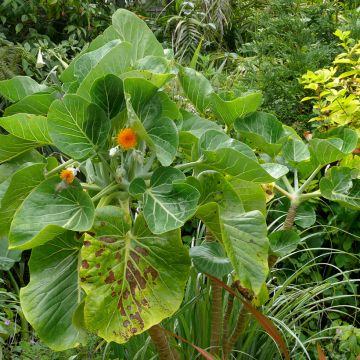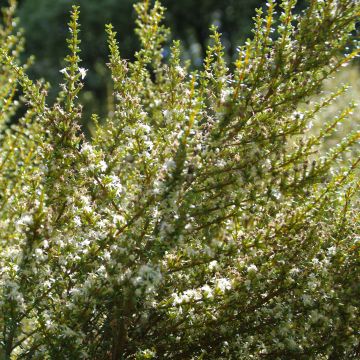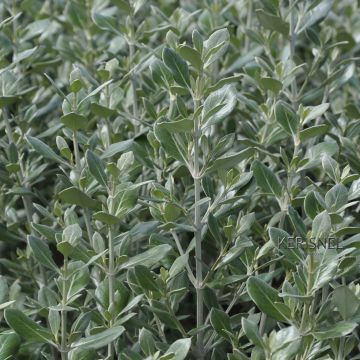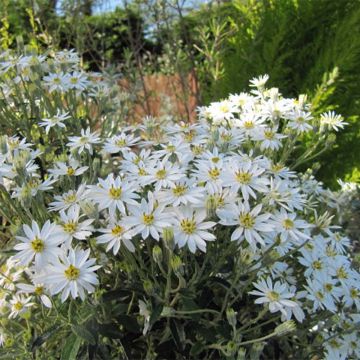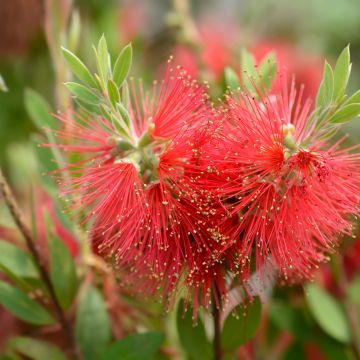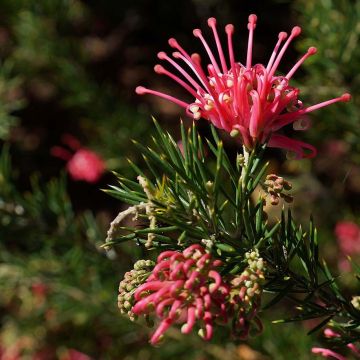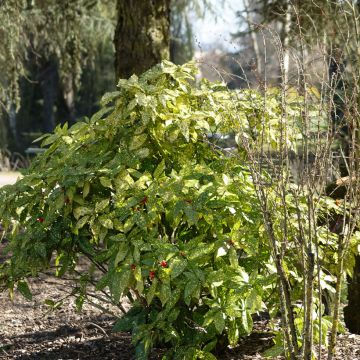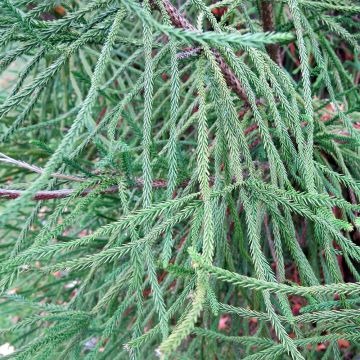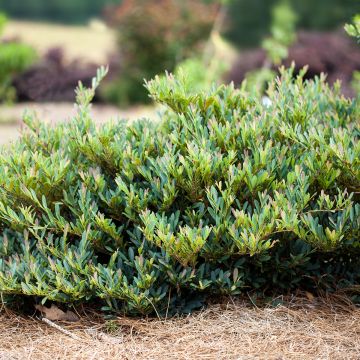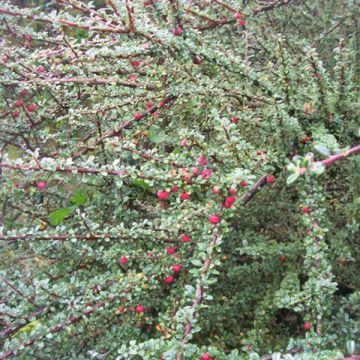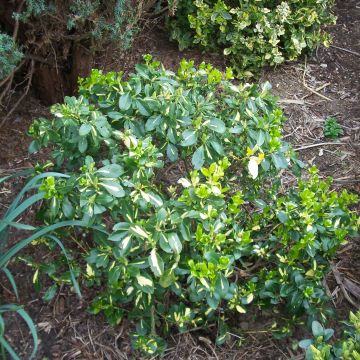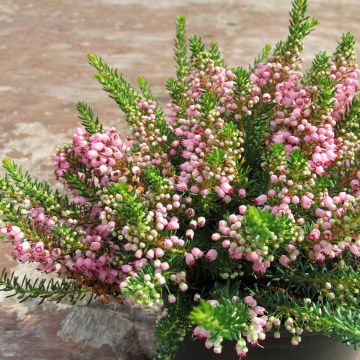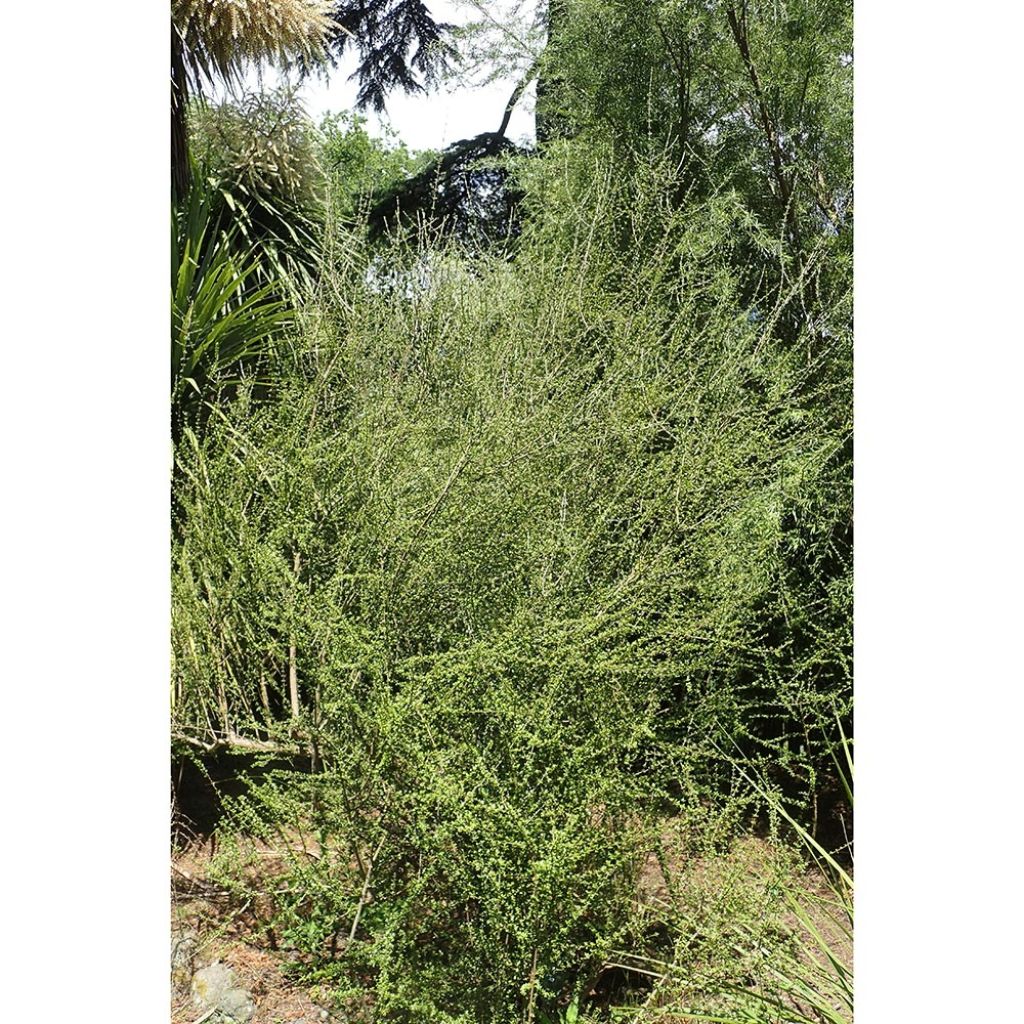

Olearia virgata
Olearia virgata - Daisy Bush
Olearia virgata
Daisy Bush, Scilly Bush
This item cannot be shipped to the selected country
Delivery charge from €5.90
Delivery to Corse prohibited
More information
Schedule delivery date,
and select date in basket
This plant carries a 24 months recovery warranty
More information
We guarantee the quality of our plants for a full growing cycle, and will replace at our expense any plant that fails to recover under normal climatic and planting conditions.
From €5.90 for pickup delivery and €6.90 for home delivery
Express home delivery from €8.90.
Delivery to Corse prohibited: UE law prohibits the import of this plant from mainland France to Corse as part of the fight against Xylella fastidiosa. Please accept our sincere apologies.
More information
Does this plant fit my garden?
Set up your Plantfit profile →
Description
The Olearia virgata is certainly not the most spectacular of its genus, but the delicacy of its branches and foliage, weaving in a few years a dense and upright mass of green-gray color, give it this unique aspect, both austere, elegant and untamed, which belongs only to coastal plants. Its summer flowering in small white-cream daisies, is discreet, but pleasantly scented, and often surrounded by a procession of too busy bees to bother the gardener. This is one of the best evergreen bushes, along with its cousin Olearia traversii, to create effective screens by the sea. This hybrid is also one of the hardiest, most vigorous and most tolerant.
The Olearia virgata is a large, more or less bushy shrub, taking on a somewhat unkempt appearance when it grows unchecked, or on the contrary very dense if it benefits from annual pruning. Its habit is generally conical and upright, reaching 2.50m (8ft) to 3.50m (11ft) in height and 1 to 2m (3 to 7ft) in width. Its growth is extremely rapid, approximately 1m (3ft) per year. It is a plant of the asteraceae family, a spontaneous hybrid between Olearia avicenniifolia and O. moschata, which is found in the wild in New Zealand, in peat bogs and wet areas, as well as in subalpine valleys. It can develop on a single trunk, reaching 10cm (4in) in diameter in favourable climates, or on the contrary be branched from the base.
Its slender, angular, flexible branches bear very narrow linear leaves, 1cm (1in) long and 2.5mm (1in) wide, reminiscent of rosemary leaves. They are light almond green on the upper side, clearly covered with a white-silver to chamois felting on the underside. Flowering takes place in June-July, in the form of panicles grouping together numerous small capitula resembling small daisies, 6mm (1in) in size, with a discreet color, white to white-cream, but pleasantly scented.
Hardy to about -13°C (8.6°F), the Olearia virgata will naturally find its place in a seaside garden, where it will form a protective screen for more fragile plants in the garden. In a medium-sized hedge, it can be used alone or combined with other evergreen shrubs such as Griselinia littoralis, bushy ceanothus ('Italian Skies', 'Concha', 'Puget Blue', 'Skylark'), Atriplex halimus, Anthyllis barba-jovis, Hippophae rhamnoides, Elaeagnus angustifolia 'Caspica', or Olearia traversii. Its silhouette blends well with that of tamarisks and Grevillea. It is perfectly adapted to gardens on the oceanic facade as it is a little wary of the intense heat in summer.
Report an error about the product description
Olearia virgata - Daisy Bush in pictures
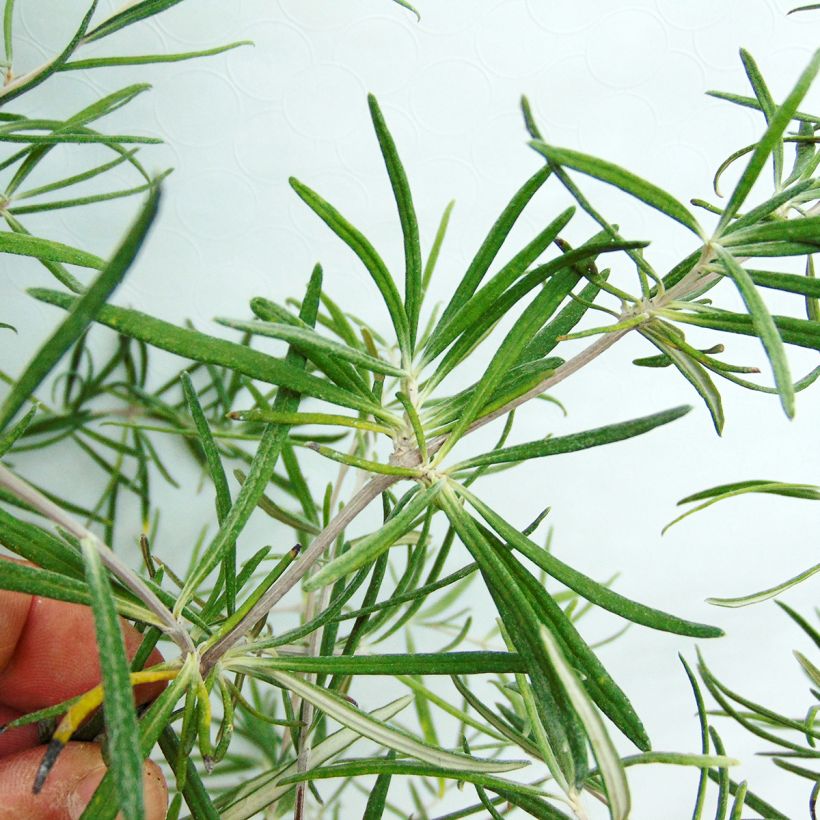

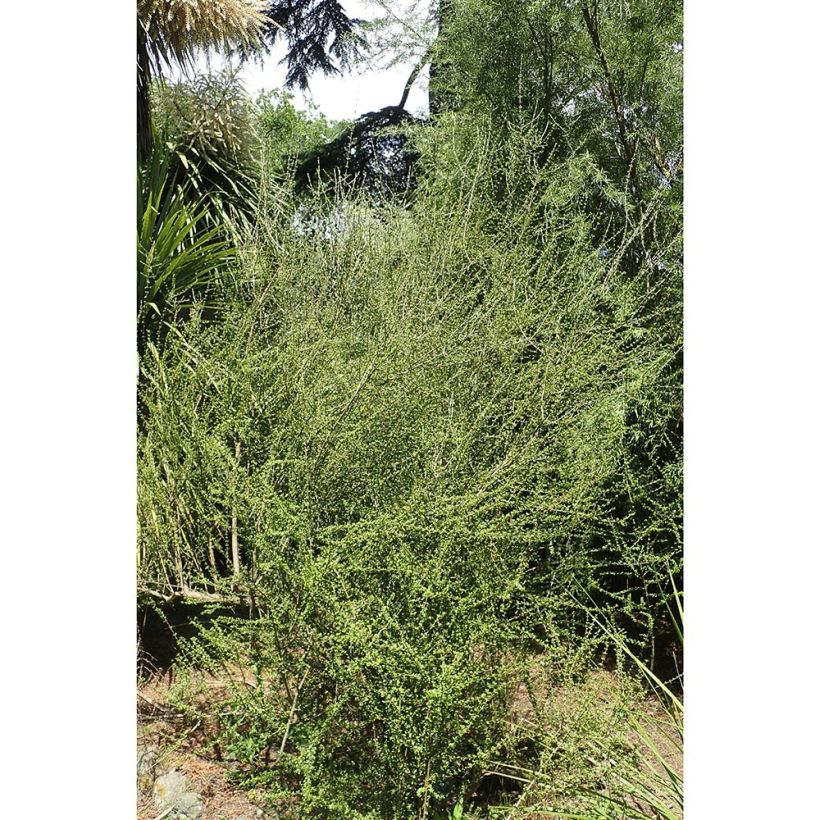

Plant habit
Flowering
Foliage
Botanical data
Olearia
virgata
Asteraceae
Daisy Bush, Scilly Bush
Oceania
Other Olearia
Planting and care
The Olearia virgata will thrive in a light, well-drained soil that is occasionally dry to moist, or even quite damp. It tolerates summer drought and poor soils quite well. A loose and deep soil, whether rocky or sandy, acidic, neutral, or even quite calcareous, will do. It withstands sea spray very well. Plant it after the last frosts in colder regions, and in September-October in warmer climates. It will flourish in full sun or partial shade. Under these conditions, it is hardy down to -12 or -13°C (10.4 or 8.6°F) however, in regions farther from the sea, it will be necessary to cultivate it in a large pot and store it indoors during winter, in a bright but unheated location. To shape and create a dense habit, you can cut back the stems in March-April each year, rather short in March, but still on the previous year's wood, to encourage the plant to branch out. If not pruned, the Olearia virgata takes on the shape of a tamarisk over the years, with a single trunk.
Cultivation in pots:
Provide good, large drainage at the bottom of the pot as the plant is prone to wind damage. Use a lightweight substrate, enriched with coarse sand and leaf compost, and apply a slow-release fertilizer in late winter and autumn. Water generously in summer, allowing the soil to dry out a bit between waterings.
Diseases and pests:
Scale insects sometimes attack the Olearia virgata. Regularly inspect the stems and undersides of the leaves to detect this pest, which forms shields or powdery clusters. In case of severe infestation, prune the plant severely just above the last bud located near the base of the stem.
Propagation: by stem cuttings after flowering, in summer.
Planting period
Intended location
Care
-
, onOrder confirmed
Reply from on Promesse de fleurs
Evergreen shrubs
Haven't found what you were looking for?
Hardiness is the lowest winter temperature a plant can endure without suffering serious damage or even dying. However, hardiness is affected by location (a sheltered area, such as a patio), protection (winter cover) and soil type (hardiness is improved by well-drained soil).

Photo Sharing Terms & Conditions
In order to encourage gardeners to interact and share their experiences, Promesse de fleurs offers various media enabling content to be uploaded onto its Site - in particular via the ‘Photo sharing’ module.
The User agrees to refrain from:
- Posting any content that is illegal, prejudicial, insulting, racist, inciteful to hatred, revisionist, contrary to public decency, that infringes on privacy or on the privacy rights of third parties, in particular the publicity rights of persons and goods, intellectual property rights, or the right to privacy.
- Submitting content on behalf of a third party;
- Impersonate the identity of a third party and/or publish any personal information about a third party;
In general, the User undertakes to refrain from any unethical behaviour.
All Content (in particular text, comments, files, images, photos, videos, creative works, etc.), which may be subject to property or intellectual property rights, image or other private rights, shall remain the property of the User, subject to the limited rights granted by the terms of the licence granted by Promesse de fleurs as stated below. Users are at liberty to publish or not to publish such Content on the Site, notably via the ‘Photo Sharing’ facility, and accept that this Content shall be made public and freely accessible, notably on the Internet.
Users further acknowledge, undertake to have ,and guarantee that they hold all necessary rights and permissions to publish such material on the Site, in particular with regard to the legislation in force pertaining to any privacy, property, intellectual property, image, or contractual rights, or rights of any other nature. By publishing such Content on the Site, Users acknowledge accepting full liability as publishers of the Content within the meaning of the law, and grant Promesse de fleurs, free of charge, an inclusive, worldwide licence for the said Content for the entire duration of its publication, including all reproduction, representation, up/downloading, displaying, performing, transmission, and storage rights.
Users also grant permission for their name to be linked to the Content and accept that this link may not always be made available.
By engaging in posting material, Users consent to their Content becoming automatically accessible on the Internet, in particular on other sites and/or blogs and/or web pages of the Promesse de fleurs site, including in particular social pages and the Promesse de fleurs catalogue.
Users may secure the removal of entrusted content free of charge by issuing a simple request via our contact form.
The flowering period indicated on our website applies to countries and regions located in USDA zone 8 (France, the United Kingdom, Ireland, the Netherlands, etc.)
It will vary according to where you live:
- In zones 9 to 10 (Italy, Spain, Greece, etc.), flowering will occur about 2 to 4 weeks earlier.
- In zones 6 to 7 (Germany, Poland, Slovenia, and lower mountainous regions), flowering will be delayed by 2 to 3 weeks.
- In zone 5 (Central Europe, Scandinavia), blooming will be delayed by 3 to 5 weeks.
In temperate climates, pruning of spring-flowering shrubs (forsythia, spireas, etc.) should be done just after flowering.
Pruning of summer-flowering shrubs (Indian Lilac, Perovskia, etc.) can be done in winter or spring.
In cold regions as well as with frost-sensitive plants, avoid pruning too early when severe frosts may still occur.
The planting period indicated on our website applies to countries and regions located in USDA zone 8 (France, United Kingdom, Ireland, Netherlands).
It will vary according to where you live:
- In Mediterranean zones (Marseille, Madrid, Milan, etc.), autumn and winter are the best planting periods.
- In continental zones (Strasbourg, Munich, Vienna, etc.), delay planting by 2 to 3 weeks in spring and bring it forward by 2 to 4 weeks in autumn.
- In mountainous regions (the Alps, Pyrenees, Carpathians, etc.), it is best to plant in late spring (May-June) or late summer (August-September).
The harvesting period indicated on our website applies to countries and regions in USDA zone 8 (France, England, Ireland, the Netherlands).
In colder areas (Scandinavia, Poland, Austria...) fruit and vegetable harvests are likely to be delayed by 3-4 weeks.
In warmer areas (Italy, Spain, Greece, etc.), harvesting will probably take place earlier, depending on weather conditions.
The sowing periods indicated on our website apply to countries and regions within USDA Zone 8 (France, UK, Ireland, Netherlands).
In colder areas (Scandinavia, Poland, Austria...), delay any outdoor sowing by 3-4 weeks, or sow under glass.
In warmer climes (Italy, Spain, Greece, etc.), bring outdoor sowing forward by a few weeks.

































